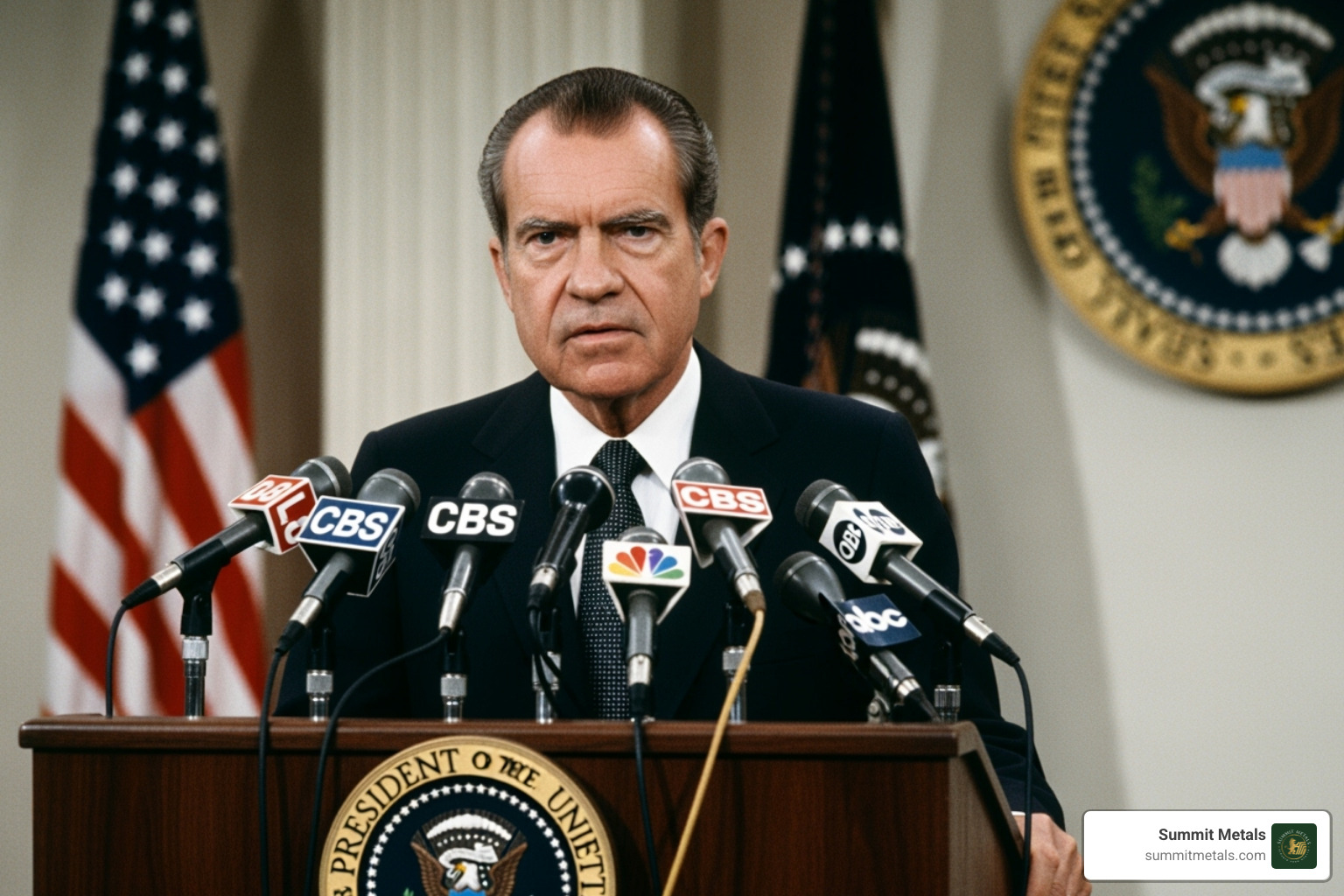Why Understanding Currency Backing Matters for Your Financial Security
Is american currency backed by gold in the United States today? No. The U.S. dollar has not been backed by gold since 1971. Here's what you need to know:
- The U.S. dollar is a fiat currency: Its value comes from government decree, not a physical commodity.
- Federal Reserve notes are not redeemable for gold, silver, or any other commodity.
- The last link to gold ended in 1971 when President Nixon closed the "gold window."
- What backs the dollar today: The full faith and credit of the U.S. government, its economic strength, and global demand.
What gives our money its value if you can't trade it for gold? This question is central to financial security. The shift from a gold-backed currency to our current fiat system fundamentally changed how American money works. Understanding this change is crucial for protecting your wealth from the risks of a system that allows the government to print money without the constraint of a physical commodity.
The transition was gradual. Until 1933, Americans could exchange dollars for gold coins. From 1934 to 1971, only foreign governments could redeem dollars for gold. Today, that connection is completely gone. Your dollars are backed by government promises, economic stability, and global demand.
I'm Eric Roach, and during my decade on Wall Street, I saw how institutional investors hedge against currency risk. I now help everyday investors apply those same strategies to protect their wealth against fiat currency vulnerabilities using physical precious metals.

The Gold Standard Era: A Look Back at U.S. Currency History
To understand why is american currency backed by gold is no longer true, we must look at its history. For most of its existence, the American dollar was tied to a physical commodity.
The U.S. initially used a bimetallic standard, where the dollar's value was derived from both silver and gold. However, fluctuating market prices for the metals made the system unstable, leading the country to effectively operate on a single metal standard at various times.
The true gold standard, where citizens could exchange paper money for gold coins, ran from 1879 to 1933. The Gold Standard Act of 1900 formalized this, defining one dollar as 1/20th of an ounce of gold. Your paper currency was essentially a receipt for gold held by the government.
After World War II, the Bretton Woods Agreement of 1944 created a new system. It fixed the price of gold at $35 per troy ounce, but only foreign governments—not U.S. citizens—could redeem dollars for gold. This global gold-exchange standard fostered decades of economic stability. However, as the U.S. money supply grew faster than its gold reserves, the system became unsustainable. Foreign countries held more dollars than the U.S. had gold to back them, setting the stage for a dramatic change.
For a deeper dive into how gold has served as money throughout history, check out our guide: A Brief History of Gold as Currency and Store of Value.
When did the U.S. dollar stop being backed by gold?
The end of the gold standard involved two key moments.
First, in 1933, during the Great Depression, President Franklin D. Roosevelt effectively outlawed private gold ownership with Executive Order 6102. To stop gold hoarding and stimulate the economy, Americans were forced to sell their gold to the Federal Reserve. This ended the ability of U.S. citizens to exchange paper dollars for gold.
The final break came on August 15, 1971, with the "Nixon Shock." Facing massive deficits from the Vietnam War and domestic spending, the U.S. saw its gold reserves dwindling as foreign countries, particularly France, redeemed their dollars for gold.

That evening, President Richard Nixon announced the U.S. would suspend the convertibility of the dollar into gold, even for foreign governments. The end of convertibility was meant to be temporary but became permanent.
Since 1971, Federal Reserve notes have not been redeemable for any commodity. The U.S. fully converted to a fiat money system, and the rest of the world soon followed. Today, no nation backs its currency with gold. This shift fundamentally changed the nature of money, which is no longer a claim on a physical asset.
To understand the economic reasoning behind this historic transition, this resource offers valuable context: Here's Why the U.S. No Longer Follows a Gold Standard.
What Replaced Gold? Answering "Is American Currency Backed by Gold" Today
So, if the answer to is american currency backed by gold is a resounding "no," what does give our money value? The U.S. dollar is now a "fiat currency," a term from the Latin for "let it be done," as it exists by government decree. Unlike gold, fiat money has no intrinsic worth. A hundred-dollar bill is just paper, yet you can trade it for anything of value.
This system works because of several powerful forces. Legal tender laws require that dollars be accepted for all debts, public and private. You can't pay your taxes in anything else, which creates a fundamental demand. The currency is also backed by the "full faith and credit of the U.S. government"—a concept representing trust in the government's stability and ability to meet its financial obligations.
The sheer economic strength of the U.S. and global demand for the dollar as the world's primary reserve currency add further support.
In this fiat system, the Federal Reserve ("the Fed") manages the money supply through monetary policy to pursue goals like stable prices and maximum employment. The Fed influences the creation of money (most of which is digital) by setting interest rates and conducting open market operations (buying and selling government bonds).
Federal Reserve notes are obligations of the U.S. government, but they are not redeemable for any commodity. Instead, the Federal Reserve Banks must hold collateral, primarily U.S. Treasury securities, equal in value to the currency in circulation. So, in a way, your dollars are backed by government debt. This system functions as long as trust in the U.S. government and its economy remains high. Unlike gold, which has held value for millennia, a fiat currency's stability is entirely dependent on that trust.
For more official information, check out The Fed's official FAQ on currency backing.
If you're wondering how to transform this paper money into something more tangible, our article on Transforming Fiat Currency into Real Money: Paper Dollars to Gold walks you through the process.
The Pillars of the Dollar's Value in a Fiat World
Now that we've established that is american currency backed by gold is no longer relevant, what keeps the dollar from becoming worthless? Its value rests on several interconnected pillars.
Economic Strength & Stability: The U.S. economy is a global powerhouse, producing a vast amount of goods and services. This massive economic activity, all conducted in dollars, creates constant, real-world demand. Furthermore, the U.S. has a long track record of political stability and honoring its debts, which builds the trust that money depends on.
Global Reserve Currency Status: The dollar's role as the world's primary reserve currency is its most powerful pillar. Central banks worldwide hold dollars for international trade and as a store of value. This creates a self-reinforcing cycle: the more the world uses dollars, the more liquid and valuable they become.

Taxes, Debt, and Global Trade: These mechanisms create concrete demand for the dollar.
- Taxes: Every U.S. person and business needs dollars to pay taxes, creating a mandatory, baseline demand for the currency.
- Government Debt: U.S. Treasury bonds are considered among the world's safest assets. Global demand for this dollar-denominated debt reinforces the currency's strength. These same securities also serve as the collateral backing physical currency.
- The Petrodollar System: Since the 1970s, critical commodities like oil have been priced and traded in U.S. dollars. This forces countries around the world to acquire and hold dollars to participate in the global energy market, creating massive, constant demand.
These factors—economic output, government stability, reserve status, and its role in taxes and global trade—work together to give the dollar its value in a post-gold standard world. This system has vulnerabilities, which is why many investors hedge with precious metals. For more on this, see our analysis: The Declining Power of the US Dollar and Its Global Implications: What It Means for Precious Metals Investors.
The Risks of Fiat Currency and the Dollar's Declining Power
Here's the uncomfortable truth about fiat currency: when is american currency backed by gold shifted from "yes" to "no," we traded the constraints of a gold standard for something far more flexible—and far more vulnerable to human error.
Inflation is the most immediate risk of a fiat system. Without the discipline of a physical commodity backing, governments can expand the money supply to fund spending, stimulate economic growth, or pay down debts. Central banks like the Federal Reserve aim for controlled inflation, but excessive money printing erodes purchasing power. History is filled with warnings, from Weimar Germany to Zimbabwe, where hyperinflation turned currency into wallpaper.
Government debt becomes easier to accumulate in a fiat world. While this allows for funding important programs, it can create a dangerous cycle of borrowing and printing more money to service the debt, risking long-term stability.
The most fragile element? Trust. A fiat currency's entire value rests on collective confidence in the government and economy behind it. If people lose faith in the government's ability to manage its economy or honor its obligations, that currency can collapse remarkably fast.

How has the purchasing power of the U.S. dollar changed over time?
The numbers tell a stark story. Since the Federal Reserve was established in 1913, the U.S. dollar has lost over 98% of its purchasing power. What a dollar could buy a century ago now costs around $50.
This decline accelerated after 1971, when the final link to gold was severed. Without that anchor, the money supply could expand more freely, leading to persistent inflation. This isn't an academic concern; it's a quiet theft of your wealth. The dollars in your savings account buy less each year. It's an invisible tax on your purchasing power.
This is precisely why institutional investors diversify into assets that can maintain their value against this backdrop of persistent inflation. For a deeper look at why precious metals serve as a hedge in this environment, check out: Why Gold and Silver: Understanding Their Value as Safe Haven Assets.
How to Build Your Own "Gold Standard" for Your Portfolio
You don't need to wait for the government to bring back the gold standard. You can create your own personal gold standard right now by adding physical precious metals to your investment portfolio.
Hedging against inflation through tangible assets like gold and silver is a strategy that has worked for thousands of years. Unlike dollars, precious metals can't be printed by government decree, and their supply is naturally limited. Physical metals provide wealth preservation when paper currencies falter and are a crucial tool for diversification, creating a counterbalance to traditional financial assets.
At Summit Metals, we're based right here in Wyoming, USA, and we work with investors from Salt Lake City, Utah, to every corner of the country. Our mission is simple: make it easy for everyday investors to own tangible assets that preserve purchasing power. We believe in transparent, real-time pricing and competitive rates through bulk purchasing, so you get genuine value without the runaround.
If you're new to this world, start with our comprehensive resource: The Ultimate Beginner's Guide to Investing in Precious Metals.
Investing in Physical Gold: Coins vs. Bars
Once you've decided to invest in physical gold, you'll face a practical question: coins or bars? Both are excellent choices, but they serve slightly different purposes.
Gold coins, like the iconic American Gold Eagle, carry a government-backed guarantee of weight and purity. Gold bars, on the other hand, typically offer a lower premium over the spot price of gold, especially when you buy larger sizes.
Here's how they stack up:
| Feature | Gold Coins (e.g., American Eagles) | Gold Bars (various sizes) |
|---|---|---|
| Premium (Cost) | Higher premium due to minting costs, intricate designs, and government guarantee. | Lower premium over spot price, especially for larger bars. More gold for your dollar. |
| Liquidity | Extremely liquid and recognized worldwide. Easy to sell individually. | Good liquidity, but larger bars may be less flexible to sell in smaller increments. |
| Security (Fraud Protection) | Government-backed face value and intricate security features make counterfeiting difficult. The U.S. Secret Service enforces this protection. | Simpler designs can be more vulnerable. Always buy from reputable dealers. |
| Storage | Compact and easier to store discreetly in smaller quantities. | Larger bars require more secure storage space and can be bulkier. |
For most investors just starting out, we recommend beginning with government-minted coins like American Gold Eagles. The peace of mind that comes with government backing and superior fraud protection makes them an excellent foundation for your holdings.
Automate Your Savings with Autoinvest
Building your personal gold standard doesn't require a massive upfront investment. Just like you contribute to a 401k over time, you can use dollar-cost averaging for metals with our Autoinvest program.
Think of it as 401k-style investing for metals. You set up automatic, recurring purchases of physical gold or silver on a schedule that fits your budget. This disciplined approach removes the stress of trying to "time the market." When prices dip, your fixed amount buys more metal; when prices rise, it buys less. Over time, this averages out your purchase price.
It's a straightforward, automated way to consistently build a position in tangible wealth that has historically preserved purchasing power. You choose what you want to buy, set your schedule, and we handle the rest—securely storing your metals or shipping them directly to you. No guesswork, just steady accumulation of real assets.
Conclusion
So, where does all this leave us? The answer to is american currency backed by gold is a definitive "no." The U.S. dollar is a fiat currency, its value derived from the full faith and credit of the U.S. government, economic strength, and its role as the world's reserve currency.
While this flexible system has enabled economic growth, it has also led to a staggering 98% decline in the dollar's purchasing power since 1913. This steady erosion of wealth is a fundamental risk of the fiat system.
Physical gold and silver offer a time-tested solution. As tangible assets that exist outside the government-controlled financial system, they cannot be devalued by money printing and have preserved wealth for millennia. Building your own "gold standard" with precious metals is a pragmatic strategy for diversification and protecting your financial future.
At Summit Metals, our mission is to make this form of wealth protection accessible. We provide transparent, real-time pricing on authenticated products you can trust.
You don't need to wait for the next crisis to act. With our Autopay subscription service, you can start building your personal reserve of tangible assets today. It's a simple, automated way to protect your purchasing power, much like contributing to a 401k. Take control and start creating your own gold standard.




